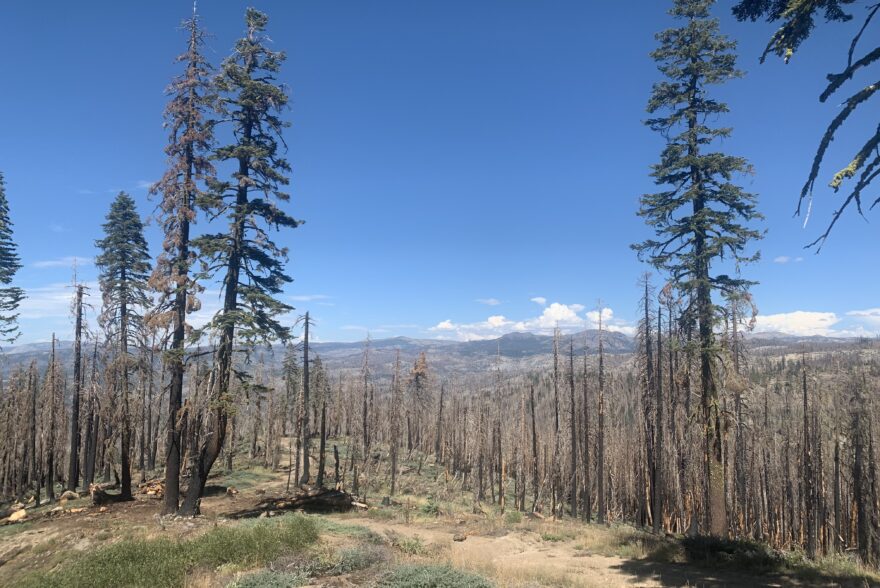Post-Fire Restoration and Reforestation: A Need, and an Opportunity


Recently, Dr. Phil Saksa, Blue Forest’s Chief Scientist, and I contributed to a paper published in Frontiers in Forests and Global Change, titled “‘Mind the Gap’—reforestation needs vs. reforestation capacity in the western United States”.
Written by: Ariella Chichilnisky du Lac, Project Development Contractor
As its title suggests, this paper details the challenges and lack of capacity associated with reforestation in the western U.S.; Dr. Saksa and I focused on how innovative public-private partnerships like the ones Blue Forest creates may be able to reduce this gap.
As our collaborators found, high-severity wildfires between 1984 and 2021 created an approximately 2.4-million–hectare need for reforestation. In this same time period, only an estimated 0.9 million hectares were actually reforested, representing less than 40% of the hectares in need of reforestation and leaving a gap of 1.5 million hectares. This gap is expected to increase to almost 3.3 million hectares by 2050. Unsurprisingly, one of the major reasons for the disparity between reforestation need and action is a lack of funding. While the recent REPLANT Act did provide a permanent increase in funding for reforestation, more funding will be needed to close this ever-widening gap.
This is where an organization like Blue Forest can come in. Blue Forest is currently exploring the potential for multiple post-fire Forest Resilience Bonds (FRBs). Like our green forest FRBs, which support forest restoration on landscapes before catastrophic wildfire can come through, a major part of developing post-fire FRBs involves engaging with beneficiaries—entities whose economic bottom lines benefit from the restoration work being completed. If these beneficiaries are able to contribute funding to post-fire projects, their contributions—along with the innovative financing mechanisms that Blue Forest is able to deploy—can accelerate the pace and scale of reforestation. So, what are the benefits of post-fire restoration, and who might care about them enough to contribute funding to these projects?
Post-fire restoration helps a landscape return to a more resilient state, decreasing the risk of high-severity wildfire and increasing the water quality, particularly in terms of sediment, in surrounding streams and rivers. Following a catastrophic wildfire, ecosystems are (perhaps counterintuitively) often at increased risk of reburn, particularly following the faster regrowth of shrubs that can catch fire much more easily than established, slower-growing trees. The aftermath of a wildfire can affect nearby water sources as well, both in terms of the quantity of water available in burnt meadows and snowpack, and the quality of available water.
These benefits can present very similarly to green forest restoration projects—decreased wildfire risk, enhanced water quality, and increased water quantity. However, some of the nuances of post-fire restoration distinguish these benefits from those of green forest projects. In particular, the water quantity benefits associated with reforestation look very different from those associated with green forest thinning. These benefits play out on a longer time-frame; rather than creating more water on the landscape immediately, they help regulate the water flow on the landscape over the course of decades, slowing runoff and snowmelt to ensure that streams continue to flow for longer throughout the spring and summer, and even into the fall.
Reforestation is also critical in another way: replanting trees in severely burned areas prevents type conversion, the process through which a landscape turns from a forest to a different type of ecosystem, often a shrubland. Without timely intervention following a catastrophic wildfire in a forested landscape, trees may not regrow quickly enough to prevent type conversion from occurring. If the landscape changes from forest to shrubland, many of the valuable ecosystem services provided by the forest might be lost. It would then take a lot more effort on the part of humans to reinstate a forest in that area than the effort required to prevent type conversion in the first place.
While post-fire restoration and reforestation do create the same suite of benefits as green forest restoration—decreased wildfire risk, increased water quantity and water quality protection, and increased ecosystem resilience—they also necessitate an important conceptual shift in the time frame within which one considers these benefits. Some benefits will present in the short-term (e.g., 3-5 or even 10 years), but some are investments being made for future decades or even centuries, as forests begin to regrow and stabilize a previously destroyed landscape.
For post-fire projects, these wildfire and water benefits can be compelling to many of the same beneficiaries of green forest projects. However, there’s an additional component to these post-fire restoration and reforestation endeavors—an acknowledgment of the longer-term impact of this work. While reforestation may not produce results as quickly as forest thinning, it is vital if we hope to see our burnt landscapes recover and continue to enjoy the ecosystem services that these forests provide.
Of course, green forest restoration can help reduce the need for post-fire restoration, and Blue Forest is working to reduce the risk of catastrophic wildfires through our conservation finance initiatives. In the meantime, we at Blue Forest will work on “minding the gap”, and demonstrating just how vital reforestation and post-fire restoration is, not just to the affected ecosystems, but to everybody.